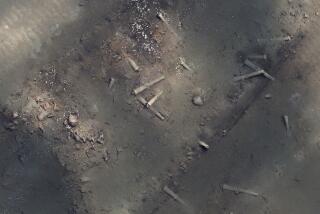Ironclad Ship More Corroded Than Expected
- Share via
CAPE HATTERAS, N.C. — Researchers studying the remains of the nation’s first ironclad ship, the Monitor, said Saturday that early tests show far more corrosion than originally thought, which could be a factor in whether the ship is raised from its ocean grave and placed in a museum.
Nearly two dozen scientists aboard a Navy ship 220 feet above the Union warship are using sophisticated monitoring devices to determine if the wreckage can be retrieved from the Atlantic, where it sank in a storm 125 years ago.
But Dane Konop, spokesman for the National Oceanic and Atmospheric Administration, emphasized that the $1.8-million expedition’s mission is only to gather data on how best to preserve the ship.
Deep Drone Camera
“We’re not here to bring up the Monitor. We’re here to bring up information,” Konop said.
Researchers using the unmanned camera Deep Drone--the same roving-and-retrieving apparatus that found debris from the space shuttle Challenger after it exploded--said the corrosion is much worse than expected.
The Monitor, the first ship built entirely of iron, is credited with ending the era of wooden warships. It sank in a storm on New Year’s Eve, 1862, while being towed to Charleston, S.C., and its 16-man crew drowned.
The Monitor study has stirred considerable debate over whether to retrieve the wreckage.
“It’s history. People actually died out there,” said Katie Oden of the Hatteras Village Civic Assn., which wants to leave the wreck where it is and build a Monitor Museum on the Outer Banks.
Ernest Peterkin, a former naval officer who began studying the Monitor before it was found in 1974, said leaving it where it is would be a disservice.
“We’ve got a great national landmark which no one can see except a few highly trained experts if you leave it down there,” he said.
More to Read
Sign up for Essential California
The most important California stories and recommendations in your inbox every morning.
You may occasionally receive promotional content from the Los Angeles Times.













